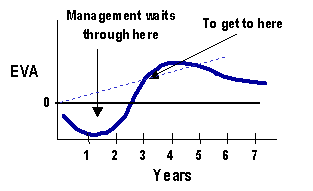Option 1 - Ignore early negative EP
 Senior management may be in a position to simply ignore negative EP in the
early years and make no adjustment at all. Aside from the obvious
simplicity of this tack, this option works well enough for managers who
are (a) significant owners of the enterprise or (b) likely to be around
when project EP is expected to become positive. If managers are
measured based on change in EP over time (which is the logical
expectation for the EP measure we are tailoring), then shortly after
project EP has turned positive, their EP will be higher than if they
had not made the investment.
Senior management may be in a position to simply ignore negative EP in the
early years and make no adjustment at all. Aside from the obvious
simplicity of this tack, this option works well enough for managers who
are (a) significant owners of the enterprise or (b) likely to be around
when project EP is expected to become positive. If managers are
measured based on change in EP over time (which is the logical
expectation for the EP measure we are tailoring), then shortly after
project EP has turned positive, their EP will be higher than if they
had not made the investment.
As long as project EP turns consistently positive any time into a future in which they have an interest, then managers will have an incentive to make value-creating investments. If they are penalized for EP declines and rewarded for EP growth, managers can even make reasonable trade offs between early year EP losses and later EP gains, although insider-managers are likely to perceive a higher risk for such projects than would diversified shareholders.